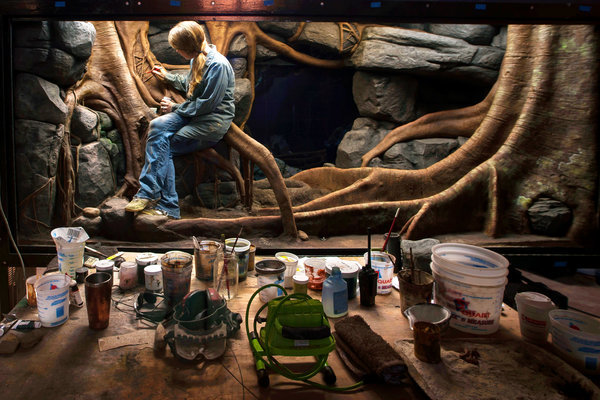Landscape Architecture for Landscape Architects › Forums › STORY BOARD › Zoo Lizard needs a Landscape Arch
- This topic has 1 reply, 8 voices, and was last updated 11 years, 11 months ago by
 Tosh K.
Tosh K.
-
AuthorPosts
-
July 16, 2013 at 4:55 pm #154504
 Trace OneParticipant
Trace OneParticipantIt is incredible to me that these poor lizards get nothing but paint and styrofoam and rebar. I would think even one natural rock would smell better to them, for years and years, than a fake setting.
does anyone else have the same reaction to this zoo design?
July 16, 2013 at 6:44 pm #154517 Tosh KParticipant
Tosh KParticipantIt’s pretty sad how they forget that the exhibit looks like ‘habitat’ to people, but that the critters probably can feel the artificial quality…
July 16, 2013 at 9:42 pm #154516 Jason T. RadiceParticipant
Jason T. RadiceParticipantSo, its Lizard Vegas?
July 16, 2013 at 11:38 pm #154515 Jason T. RadiceParticipant
Jason T. RadiceParticipantHow did I miss this one…I’m slipping inmy advancing years.
LIZ Vegas!
July 16, 2013 at 11:50 pm #154514 Trace OneParticipant
Trace OneParticipant“Learning from Lizard Vegas” ventura und Braun 2020?
July 17, 2013 at 2:15 am #154513 Wyatt Thompson, PLAParticipant
Wyatt Thompson, PLAParticipantThis doesn’t surprise me. Maintaining lush vegetation and a thriving lichen colony inside the exhibit may not be practical given the horticultural resources available. Zoos also have sanitary concerns. A big concrete box is much easier to clean and disinfect than one that embraces a more ecological approach.
July 17, 2013 at 9:27 am #154512 Trace OneParticipant
Trace OneParticipantthe San Diego zoo is actually a world-famous botanical collection in addition to being an animal collection – as far as I know, you can design zoo cages with plants, and should design with plants.
July 18, 2013 at 3:29 am #154511 Wyatt Thompson, PLAParticipant
Wyatt Thompson, PLAParticipantI’m not saying zoo exhibits can’t or shouldn’t be designed with plants. I completely agree with you. My point was that maintenance has to be a consideration – in any planting, not just zoos. How many times do plantings fail from lack of the owner’s understanding of the maintenance required? Zoos are somewhat unique because there is both animal and plant maintenance to consider.
Many large zoos do maintain wonderful botanical collections, and they have the staff to support that educational component of their facility. I’ve never been to the Bronx Zoo so I don’t know what their other exhibits look like, what their horticultural capabilities are, or what that particular exhibit will even look like when its finished.
July 18, 2013 at 1:20 pm #154510 Rob HalpernParticipant
Rob HalpernParticipantWe don’t know why the zoo, which understands better than anyone the importance of planted exhibits (as former Curator of Horticulture there I can attest to that) chose this for these lizards. It does appear that what we see here is what the exhibit will be… no plantings. But perhaps for these animals the climbing and hiding opportunities are more important for their well-being than the feel of soil and wood and leaf.
Furthermore, this species of lizard is very rare. Perhaps it is not about sanitation so much as sterilization?
July 18, 2013 at 6:25 pm #154509 Trace OneParticipant
Trace OneParticipantTrue Rob. Komodo’s in America, who knows what the constraints are. As an animal lover, it does seem sad, tho, how carefully they are painting lichen, when I am sure the Komodo could care less. And may be better off without the paint fumes.. But my ignorance and ethnocentrism are likely unbounded, in that view. Thanks for your comment.
July 18, 2013 at 9:24 pm #154508 Rob HalpernParticipant
Rob HalpernParticipantWell, this particular exhibit appears to be for an even rarer forest relative of komodos, and the faux lechens etc are to educate the public about the animals and their habitat. There will be no fumes by the time the animals are put here.
If these are indeed the blue monitors, they are only recently known to biologists and this may in fact be a compromise between keeping them in the lab in a tank to be studied and putting them on display for the public to educate people about the threatened unknown species of tropical forests in danger
July 20, 2013 at 3:23 pm #154507 Richard L. WingetParticipant
Richard L. WingetParticipantI’ve done many animal exhibits both interior and exterior and it is important to add natural elements in the exhibit for a variety of reasons. Curators and handlers have the animals concern at heart and all exhibits have a holding paddock for the animals, this allows the exhibit to be maintained, cleaned and hidey holes refurbished with food. It’s sort of like dressing a set, you have to get it ready each day! This is true with aquariums as well.
Sadly people litter the exhibits and throw things, sometimes dangerous things inside that need to be removed daily. Sometimes people themselves go in! Natural logs and rocks are necessary for a believable exhibit. Artificial is required to hide doors, heater, coolers and other man made elements required for longevity of the animal and high visibility. A realistic exhibit fosters breeding and teaches viewers about the species. I could go on and on but you get the point. Nice work by the way, who is that in there? You go girl!
July 20, 2013 at 5:05 pm #154506Anonymous
InactiveInteresting discussion, I don’t know if I really have a strong opinion on this, but what Bob and Wyatt makes a lot of sense to me. But sometimes I think we humans project our human thought and emotion on animals. I’m definitely guilty of it with my pets. I mean who really knows what the lizard likes or thinks about things. Maybe these animals with their simple brains just want to eat and poop and don’t really care about plants, lichens, humus and the like. Then you have to think how happy can they be no matter how “naturalized” their box is, but then again I’m projecting the concept of freedom on a lizard.
August 11, 2013 at 12:08 pm #154505Anonymous
Inactive -
AuthorPosts
- You must be logged in to reply to this topic.



